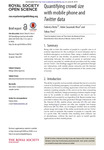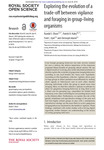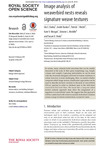Education: Recent submissions
Now showing items 521-540 of 806
-
Membrane shrinkage and cortex remodelling are predicted towork in harmony to retract blebs
(The Royal Society, 2015)Numerous cell types undergo an oscillatory form of dynamics known as blebbing, whereby pressure-driven spherical pro-trusions of membrane (known as blebs) expand and contract over the cell’s surface. Depending on the cell ... -
Modelling the species jump
(The Royal Society, 2015)The scientific understanding of the driving factors behind zoonotic and pandemic influenzas is hampered by complex interactions between viruses, animal hosts and humans. This complexity makes identifying influenza viruses ... -
Quantifying crowd size with mobile phone and Twitter data
(The Royal Society, 2015)Being able to infer the number of people in a specific area is of extreme importance for the avoidance of crowd disasters and to facilitate emergency evacuations. Here, using a football stadium and an airport as case ... -
Eye spots in Lepidoptera attract attention in humans
(The Royal Society, 2015)Many prey species exhibit defensive traits to decrease their chances of predation. Conspicuous eye-spots, concentric rings of contrasting colours, are one type of defensive trait that some species exhibit to deter predators. ... -
Amodel for non monotonic intensity coding
(The Royal Society, 2015)Peripheral neurons of most sensory systems increase their response with increasing stimulus intensity. Behavioural responses, however, can be specific to some intermediate intensity level whose particular value might be ... -
Functional morphology and efficiency of the antenna cleaner in Camponotus rufifemurants
(The Royal Society, 2015)Contamination of body surfaces can negatively affect many physiological functions. Insects have evolved different adaptations for removing contamination, including surfaces that allow passive self-cleaning and structures ... -
Exploring the evolution of a trade off between vigilance and foraging in group living organisms
(The Royal Society, 2015)Even though grouping behaviour has been actively studied for over a century, the relative importance of the numerous proposed fitness benefits of grouping remain unclear. We use a digital model of evolving prey under ... -
How visual perceptual grouping influences foot placement
(The Royal Society, 2015)Everybody would agree that vision guides locomotion but how does vision influence choice when there are different solutions for possible foot placement? We addressed this question by investigating the impact of perceptual ... -
Familiar and unfamiliar face recognition in crested macaques
(The Royal Society, 2015)Many species use facial features to identify conspecifics, which is necessary to navigate a complex social environment. The fundamental mechanisms underlying face processing are starting to be well understood in a variety ... -
Leaf processing behaviour in Attaleafcutter ants
(The Royal Society, 2015)Leafcutter ants cut trimmings from plants, carry them to their underground nests and cut them into smaller pieces before inoculating them with a fungus that serves as a primary food source for the colony. Cutting is ... -
Multitasking during social interactions in adolescence and early adulthood
(The Royal Society, 2015)Multitasking is part of the everyday lives of both adolescents and adults. We often multitask during social interactions by simultaneously keeping track of other non-social information. Here, we examined how keeping track ... -
Tiarajudens eccentricus and Anomocephalus africanus, two bizarre anomodonts (Synapsida, Therapsida) with dental occlusion from the Permian of Gondwana
(The Royal Society, 2015)Anomodontia was a highly successful tetrapod clade during the Permian and the Triassic. New morphological information regarding two bizarre basal anomodonts is provided and their palaeoecological significance is explored. ... -
Image analysis of weaverbird nests reveals signature weave textures
(The Royal Society, 2015)In nature, many animals build structures that can be readily measured at the scale of their gross morphology (e.g. length, volume and weight). Capturing individuality as can be done with the structures designed and built ... -
The evolution of popular music: USA 1960–2010
(The Royal Society, 2015)In modern societies, cultural change seems ceaseless. The flux of fashion is especially obvious for popular music. While much has been written about the origin and evolution of pop, most claims about its history are anecdotal ... -
Evidence for a pervasive ‘idling-mode’ activity template in flying and pedestrian insects
(The Royal Society, 2015)Understanding the complex movement patterns of animals in natural environments is a key objective of ‘movement ecology’. Complexity results from behavioural responses to external stimuli but can also arise spontaneously ... -
Exotic invaders gain foraging benefits by shoalingwith native fish
(The Royal Society, 2014)Freshwater habitats are under increasing threat due to invasions of exotic fish. These invasions typically begin with the introduction of small numbers of individuals unfamiliar with the new habitat. Oneway in which the ... -
Polygyny without wealth
(The Royal Society, 2015)The occurrence of polygynous marriage in hunter–gatherer societies, which do not accumulate wealth, remains largely unexplored since resource availability is dependent on male hunting capacity and limited by the lack of ... -
Simple graphmodels of information spread in finite populations
(The Royal Society, 2015)We consider several classes of simple graphs as potential models for information diffusion in a structured population. These include biases cycles, dual circular flows, partial bipartite graphs and what we call ‘single-link’ ... -
An efficient interpolation technique for jump proposals in reversible jump Markov chain Monte Carlo calculations
(The Royal Society, 2015)Selection among alternative theoretical models given an observed dataset is an important challenge in many areas of physics and astronomy. Reversible-jump Markov chain Monte Carlo (RJMCMC) is an extremely powerful technique ... -
The growth threshold conjecture
(The Royal Society, 2015)Adaptive immune responses depend on the capacity of T cells to target specific antigens. As similar antigens can be expressed by pathogens and host cells, the question naturally arises of how can T cells discriminate friends ...




















